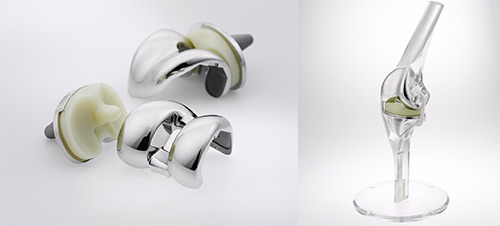Why an operation?
The wear of the cartilage is irreversible and osteoarthritis does not heal spontaneously. The natural progression is the gradual deterioration of the joint, with increasingly limited mobility and greater difficulty in walking.
The anti-inflammatories and painkillers that were enough to start with are no longer effective, and so the question of surgery is raised.
The objective of the operation is to relieve the pain, recover joint mobility and return to normal walking.
What is a total knee replacement?
The objective of a knee replacement is to remove the areas of bone and cartilage that are worn, and to replace them with artificial parts of the same shape.
According to your morphology, this procedure can be performed using a minimally invasive technique, causing as little damage as possible to the muscles and tendons around the knee.
This technique has advantages in relation to traditional surgery, including faster post-operative recovery.

Post-operative rehabilitation and return to activities
The day after the operation, the physiotherapist will get you up and help you to walk. Walking sticks will be useful for the first few days, but will be rapidly abandoned. You can go up and down stairs within 3 days. When you leave the clinic, the rehabilitation can be carried out at a centre or at your physiotherapist’s.
Driving can be envisaged after the 1st month and you can generally return to work after the 2nd month, depending on your profession; office work can be sooner. You can progressively resume sports activities after the 3rd month.

What are the risks and complications?
In addition to the risks associated with any surgery and the anaesthetic, there are some risks specific to this surgery:
- Joint stiffness can develop if the post-operative rehabilitation is not carried out properly.
- A haematoma may appear around the area operated on due to bleeding. According to the extent of the bleeding, drainage or a transfusion may be necessary.
- The occurrence of an infection, although rare (risk below 1 % in our establishment), is a serious complication and can require revision replacement and a long-term course of antibiotics. When detected rapidly, a lavage of the prosthesis and a course of antibiotics are enough.
- The nerves around the knee may be damaged accidently. This rare complication may cause pain and a loss of feeling in certain parts of the leg.
- Small blood clots can form and block the veins in the legs leading to phlebitis. In order to prevent this complication, an anticoagulant is prescribed and support stockings are worn for several weeks.
This list of risks is not exhaustive. Your surgeon can provide you with any additional explanations and will be available to discuss the advantages, disadvantages and risks of each specific case with you.
What is the expected outcome of the operation?
The results of this technique are very encouraging as an often spectacular disappearance of the pain along with a rapid recovery of mobility and muscle strength are observed. Normal walking with no limping is generally recovered within one month post-op.
Even if the return to activities is often unrestricted, it is preferable to avoid physical work and violent sports as these activities can increase the wear and decrease the lifespan of the prosthesis despite the use of new, more resistant materials. Some activities like cycling, swimming, golf and walking are however possible, and even recommended, whereas care must be taken with skiing, tennis and jogging.
The average lifespan of a knee replacement is about 20 years. With the progress in the materials used today, as well as the computer-assisted positioning of the implants, we hope that the results and the longevity will continue to improve.
